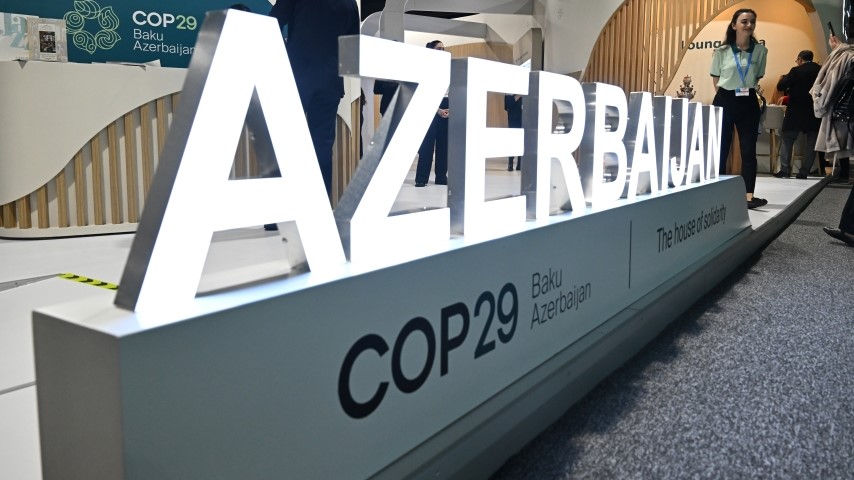Azerbaijan’s Calls For Peace Demonstrate The Shallow Absurdity Of COP29
Photo by IAEA Imagebank, CC BY 2.0
The annual farce of the United Nations climate change talks, this year known as COP29, has rolled around again. Ongoing as I write, this year’s prospects aren’t looking particularly rosy. Azerbaijan, a petrostate that actively intends to expand both its fossil fuel and its mining operations, represents another terrible choice of host country following the United Arab Emirates and Egypt, given the ecologically destructive practices that fuel its economy. But it gets even more absurd, as, in its capacity as COP host, Azerbaijan has called for a “global truce,” demanding that all countries presently engaged in conflict lay down arms.
It is a noble call, to be sure, but one which grates just a little bit, given that it was issued by an authoritarian petrostate which oppresses its own people and has been accused recently of ethnic cleansing and other war crimes.
The corrupt Azerbaijani regime, headed up by President Ilham Aliyev and his extended family, has brutally cracked down on civil society within the country, arresting and allegedly torturing journalists and activists critical of the government, while new laws have restricted the work of NGOs and media organizations there. Freedom House, in an assessment of the country’s political rights and civil liberties, issued Azerbaijan with a miserable score of seven out of 100 in 2024, indicative of how profoundly repressive the country has become under Aliyev.
Arguably the darkest moment in Azerbaijan’s recent history is what has happened in the disputed Nagorno-Karabakh region, a landlocked, mountainous area in the South Caucasus with a complicated history. During the Soviet era, the region, despite being home to a majority ethnic Armenian population, became a part of the Azerbaijan Soviet Socialist Republic, albeit while retaining a broad degree of regional autonomy. The tensions between the Armenians of Nagorno-Karabakh and the Azeris surrounding them were tempered by the fact both populations were a part of the Soviet Union, but, as the U.S.S.R. began to collapse, they bubbled to the surface once again.
As Azerbaijan and Armenia were emerging as independent nations throughout the late ’80s and early ’90s, Nagorno-Karabakh again became a source of contention between the two sides. The ethnic Armenians of Nagorno-Karabakh, backed by Armenia proper, sought to break away from Azerbaijan and to declare their own republic. This resulted in the bloody First Nagorno-Karabakh War, which, between 1988 and 1994, saw 30,000 deaths and the displacement of hundreds of thousands of people from both sides. By the conflict’s conclusion, the Armenians of Nagorno-Karabakh had taken control of the region, not to mention some additional Azerbaijani land around it, and they declared their own independent republic, which they called Artsakh. The Artsakh Republic was never internationally recognized — not even by Armenia itself, though it did support it financially and militarily. Legally speaking, Nagorno-Karabakh remained a part of Azerbaijan, and tensions never faded.
Armed clashes sporadically broke out over the status of Nagorno-Karabakh in the years that followed the first war, and things, once again, came to a head in 2020. Azerbaijan, backed by Turkey, launched the Second Nagorno-Karabakh War, managing, after 44 days of conflict, to take control of parts of Nagorno-Karabakh and proclaim a victory. A Russia-brokered ceasefire agreement officially granted Azerbaijan control of the areas around Nagorno-Karabakh it had lost during the first war, but, for the Azeri regime, that wasn’t yet enough.
In 2022, the Azerbaijani government sent a bunch of its citizens to the edge of Nagorno-Karabakh, where they posed as environmental protestors, but, in actual fact, were there to impose a blockade on the enclave. The Azeri regime was deliberately starving the residents of Nagorno-Karabakh, blocking essential goods like food and medicine from entering the territory, and placing the lives of children, pregnant women, the elderly, disabled people, and those with health conditions at particular risk. The population suffered greatly, before, in September 2023, Azerbaijan violated the 2020 ceasefire agreement and sent troops into the region. The Republic of Artsakh collapsed and the territory was absorbed by Azerbaijan, meaning almost the entire population of ethnic Armenians that lived there — about 100,000 people by that point — was forced to flee, mostly going to Armenia.
Azerbaijan’s actions throughout this campaign have been characterized as ethnic cleansing.
Not only that, but since the Azeri takeover of the region, reports have suggested that signs of the centuries-long ethnic Armenian presence there are being wiped out, with Armenian historical, religious, political, and residential sites being demolished. Most disturbingly, perhaps, New Lines Magazine in early 2024 published an investigation suggesting that Azerbaijan may literally have, at one point, been planning to force the Armenians of Nagorno-Karabakh into concentration camps.
This is the jet-black context in which Azerbaijan, in its role as the esteemed host of COP29, has called for peace around the globe.
If the world is to begin addressing the climate crisis, it will mean countries pulling together to collaborate on solutions and adaptation measures. It will mean implementing more democracy, not less, and it will mean open public engagement in which citizens do not face persecution for voicing their concerns. It will mean redirecting resources away from war and towards energy transition and climate adaptation. But the COP has repeatedly proven it is not going to facilitate anything like this. With authoritarian, war-making, fossil-fuel-extracting Azerbaijan leading the way this year, the farcical corruption of the summit couldn’t be plainer.